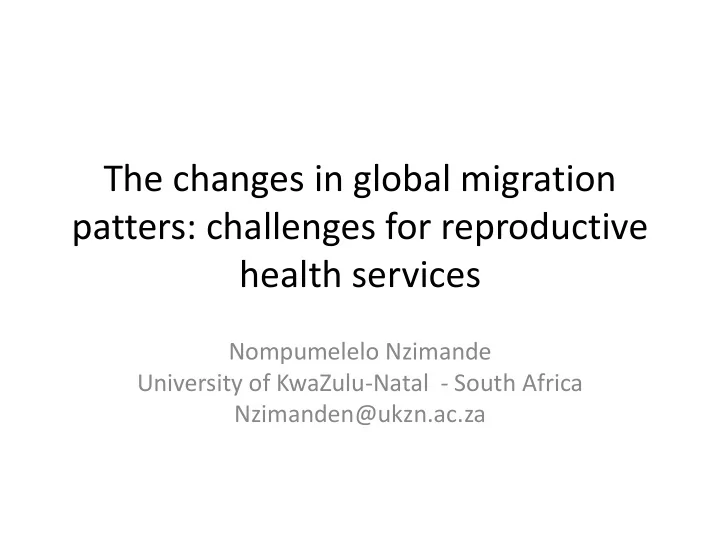

The changes in global migration patters: challenges for reproductive health services Nompumelelo Nzimande University of KwaZulu-Natal - South Africa Nzimanden@ukzn.ac.za
Global migration patterns • World Migration Report 2013 published by IOM (International Organization for Migration) indicate that : “ there has been increasing international debate about how best to harness the benefits of migration for development. Yet migration remains inadequately integrated into development frameworks at national and local levels ”
Background: Key points • Placing migration at the centre of the debate – Demographic shift contribution of migration to growth population • Migration is not just a South-North phenomenon • Migrants improve human development but many struggle to access services including RH • Developing a global barometer of migrant wellbeing
Contribution of Natural Increase and Net migration to pop change
South-South Migration S - N N – N S - S N - S Stock % Stock % Stock % Stock % UN DESA 74,297 35 53,464 25 73,158 34 13,279 6 WB 95,091 45 36,710 17 75,355 35 7,044 3 UNDP 86,873 41 32,757 15 87,159 41 7,410 3
Challenges for health • Migration is becoming and important aspect of population change even in developing countries • S-N and S-S represent major migratory flows • S-S movements increasing • Important to note that informal movements are more common in S-S movements leading to: – higher unrecorded moves – Greater vulnerability of migrants in accessing health care facilities • Challenge in projecting future migration change
Gender and migration: Female migrants as a share of total migrant stock
Implications and challenges for reproductive health • Although a greater part of migrants (both males and females) reside in the North – it is worth noting that female migration is on the rise • S-S migration is economically important due to – Potential scale of remittances – But life experiences (wellbeing) of the migrants is not understood – including access to health
Migrants my age and gender
Migrants my age and gender
Migrants my age and gender
Implications for reproductive health • The percentage of migrants up to 24 years of age is higher in the South • RH important for both sexes • Feminization of migration needs to be matched with relevant services • Moreover, younger female migrants in reproductive ages require RH services
Global stock of refugees and students
Implications for reproductive health • Majority of refugees originate and live in the South • Refugees are more vulnerable • Policies and plans have to acknowledge this: – e.g. South Africa has developed a capacity building program on “population migration, urbanization and planning for development”
Implications for reproductive health • The figure for S-S students is lower compared to S-N • Important to note that “more than half of the international students originating in countries belonging to SADC decide to study within the region, more precisely South Africa” (UNESCO, 2012)
Recommend
More recommend